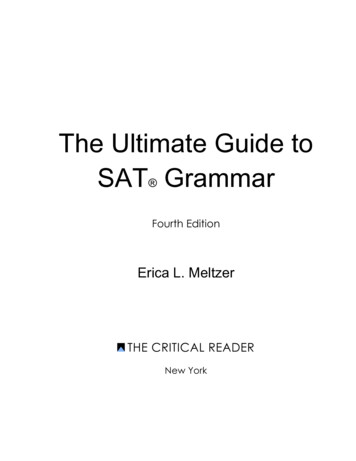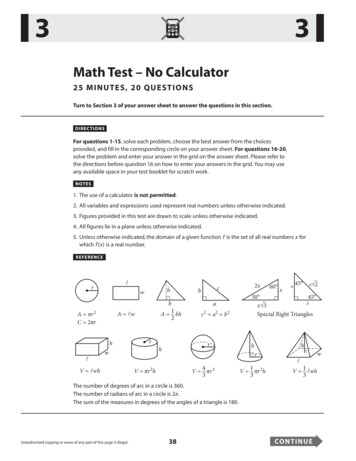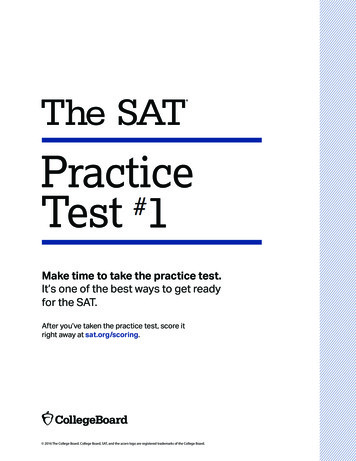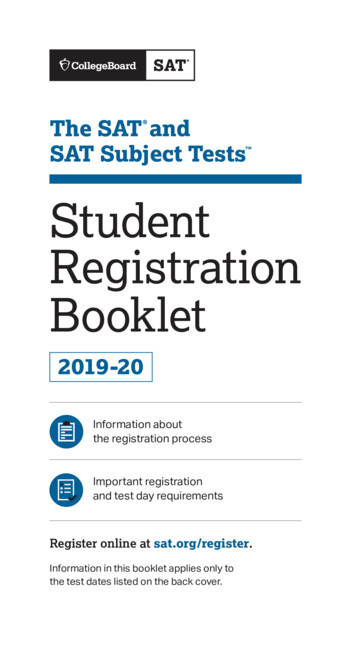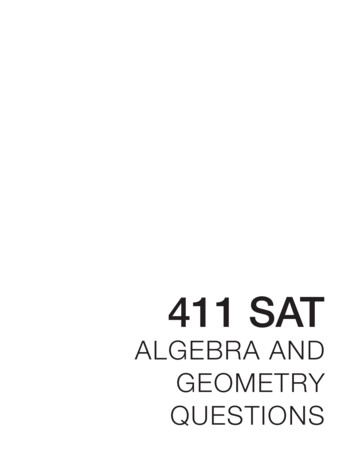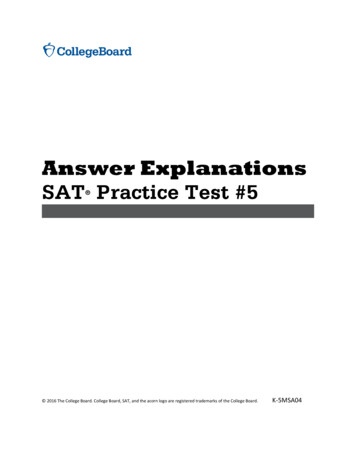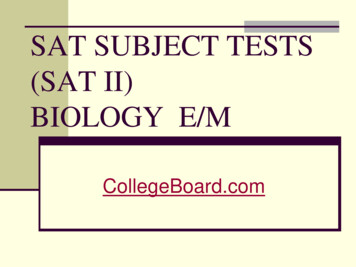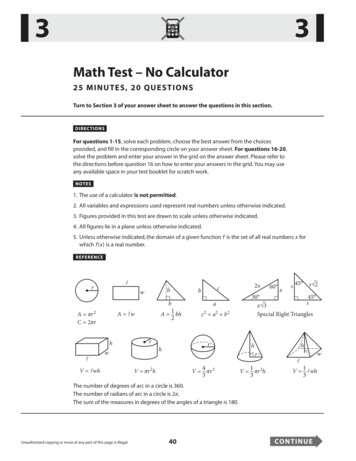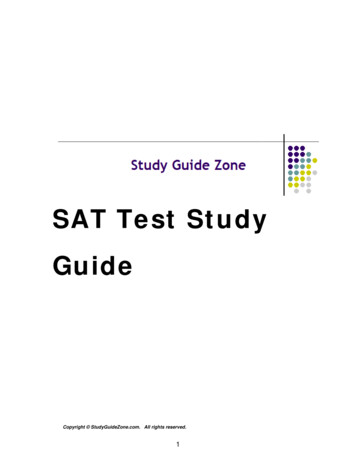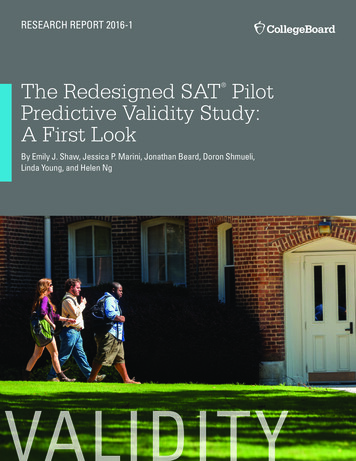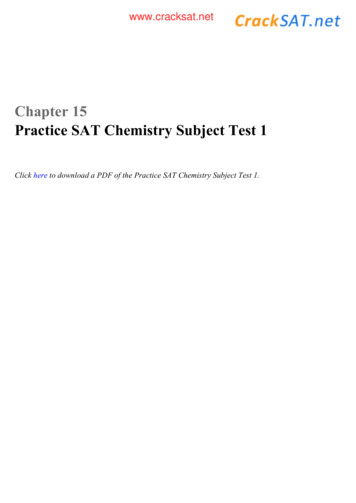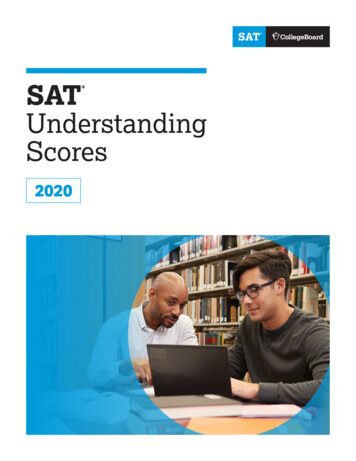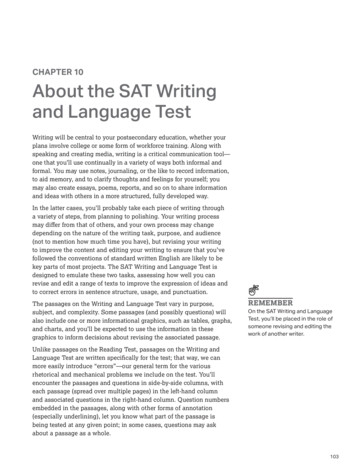
Transcription
CHAPTER 10About the SAT Writingand Language TestWriting will be central to your postsecondary education, whether yourplans involve college or some form of workforce training. Along withspeaking and creating media, writing is a critical communication tool—one that you’ll use continually in a variety of ways both informal andformal. You may use notes, journaling, or the like to record information,to aid memory, and to clarify thoughts and feelings for yourself; youmay also create essays, poems, reports, and so on to share informationand ideas with others in a more structured, fully developed way.In the latter cases, you’ll probably take each piece of writing througha variety of steps, from planning to polishing. Your writing processmay differ from that of others, and your own process may changedepending on the nature of the writing task, purpose, and audience(not to mention how much time you have), but revising your writingto improve the content and editing your writing to ensure that you’vefollowed the conventions of standard written English are likely to bekey parts of most projects. The SAT Writing and Language Test isdesigned to emulate these two tasks, assessing how well you canrevise and edit a range of texts to improve the expression of ideas andto correct errors in sentence structure, usage, and punctuation.The passages on the Writing and Language Test vary in purpose,subject, and complexity. Some passages (and possibly questions) willalso include one or more informational graphics, such as tables, graphs,and charts, and you’ll be expected to use the information in thesegraphics to inform decisions about revising the associated passage.REMEMBEROn the SAT Writing and LanguageTest, you’ll be placed in the role ofsomeone revising and editing thework of another writer.Unlike passages on the Reading Test, passages on the Writing andLanguage Test are written specifically for the test; that way, we canmore easily introduce “errors”—our general term for the variousrhetorical and mechanical problems we include on the test. You’llencounter the passages and questions in side-by-side columns, witheach passage (spread over multiple pages) in the left-hand columnand associated questions in the right-hand column. Question numbersembedded in the passages, along with other forms of annotation(especially underlining), let you know what part of the passage isbeing tested at any given point; in some cases, questions may askabout a passage as a whole.103
PART 2 Evidence-Based Reading and WritingPRACTICE ATsatpractice.orgGetting a good score on the Writingand Language Test isn’t about roterecall of language “rules.” You’llinstead need to consider context—often at the paragraph or passagelevel—when choosing your answer.You’ll be asked questions that deal with the expression of ideasin a passage—specifically, questions about topic development,organization, and effective language use. You’ll also be given questionsthat require you to apply your knowledge of the conventions ofstandard written English to the passage—specifically, to recognizeand correct errors in sentence structure, usage, and punctuation. All ofthe questions are based in multiparagraph passages, so each questionhas an extended context and no question requires the rote recall oflanguage “rules.” As a group, the questions call on the same sorts ofrevising and editing skills that you’re using already in your high schoolclasses and that are important to have in order to be ready for and tosucceed in college and workforce training programs.The rest of this chapter offers a general description of the Writing andLanguage Test. The following two chapters go into more detail aboutthe question types that are included on the test.Writing and Language Test FormatBefore we delve into the passages and questions, let’s take a look atthe test format. Understanding how things work will help you get aquick start on test day and allow you to focus your full attention onanswering the questions.REMEMBERIn many cases, a boxed questionnumber as well as underliningspecify the part of the passage that aparticular question refers to.REMEMBERSome questions with an underlinedportion may not include directions.For these questions, assume thatyour task is to select the answerthat’s the most effective or correct.REMEMBERSome questions include a“NO CHANGE” option; choose thisanswer if you think the original textpresented in the passage is the bestchoice.104A sample of the Writing and Language Test format appears on thenext page. Each passage will be headed by a title in boldface type.The passage itself will be spread across multiple pages (so, unlessyou’re on the last question set on the test, don’t assume that you’vereached the end of a given passage until you see the title of the nextone). The passage is positioned in the left-hand column of each page,and the questions related to the portion of the passage on that pageappear in order in the right-hand column.Most questions are “anchored” to a particular location in the passagevia a boxed question number in the passage. Sometimes this boxednumber will stand alone; in these cases, the associated question willtell you what to do, such as consider adding a sentence at that point.At other times, this boxed number will be followed by underlinedtext; for these questions, you’ll have to consider which of four answeroptions results either in the most rhetorically effective expression inthe context of the passage or in an expression that’s correct in termsof standard written English sentence structure, usage, or punctuation.While some questions with an underlined portion include a questionspecific direction (as in question 1), others don’t (as in question 2).When there are no additional directions, assume that you’re to choosethe option that’s the most rhetorically effective in context or that resultsin a conventionally correct expression. If a question includes a “NOCHANGE” option—it’ll always be the first answer choice—pick itif you think the original version presented in the passage is the bestoption; otherwise, pick one of the three alternatives.
Chapter 10 About the SAT Writing and Language TestQuestions 1-11 are based on the following passage.1Which choice best maintains the sentence patternalready established in the paragraph?A) NO CHANGEB) Coordinating stoplight timing can help alleviaterush hour traffic jams in a congested downtownarea.C) Stoplight timing is coordinated to alleviate rushhour traffic jams in a congested downtown area.D) In a congested downtown area, stoplight timing iscoordinated to alleviate rush hour traffic jams.A subway system is expanded to provide service to agrowing suburb. A bike-sharing program is adopted toencourage nonmotorized transportation. 1 To alleviaterush hour traffic jams in a congested downtown area,stoplight timing is coordinated. When any one of thesechanges 2 occur, it is likely the result of careful analysisconducted by transportation planners.The work of transportation planners generallyincludes evaluating current transportation needs,2A)B)C)D)NO CHANGEoccur, they areoccurs, they areoccurs, it isYou may come across some other forms of passage annotation as well.If the paragraphs in a passage or the sentences in a paragraph arenumbered, one or more questions will refer to those numbers. You maybe asked, for example, to consider where a particular sentence shouldbe placed in a paragraph (e.g., “after sentence 3”). You may also, onoccasion, be advised that a particular question asks about the passageas a whole. In that case, you’ll have to apply your understanding of theentire passage when answering the question.Writing and Language Test PassagesThe passages on the Writing and Language Test are varied in orderto better assess whether you can apply your revising and editingknowledge and skills in a wide range of contexts important for collegeand career. Passages differ in purpose: Some primarily serve to relateevents or experiences narratively, while others serve mainly to conveyinformation, explain a process or idea, or argue for a particular way ofthinking or acting. Passages also represent numerous different subjectareas. In addition, passages vary in complexity, with some beingrelatively straightforward and others being highly challenging.Let’s consider some of the key features of Writing and Language Testpassages.§ Purpose: As previously mentioned, some Writing and LanguageTest passages are focused on narrating experiences in a storylikeway. Though there is no fiction passage on the Writing andLanguage Test (as there is on the Reading Test), a nonfictionnarrative, such as one recounting a historical event or relating the105
PART 2 Evidence-Based Reading and Writingsteps in a scientific investigation, is found in each administration.Other passages on the test serve mainly to inform, to explain, or toargue in support of a claim.REMEMBERPassage purpose, subject matter,and complexity will vary in order toprovide a broad assessment of yourrevising and editing knowledge andskills.§ Subject: Writing and Language Test passages cover a variety ofsubject areas, including career-related topics, the humanities,history/social studies, and science. Passages on career-relatedtopics aren’t workplace documents, such as memos or reports;instead, they’re general-interest pieces on jobs, trends, issues,and debates in common career pathways, such as health care andinformation technology. Humanities passages focus on the artsand letters and include texts on fine art, film, music, literature, andthe like. History/social studies passages include texts on topicsin history as well as in the social sciences, such as anthropology,archaeology, economics, and psychology. Science passages coverfoundational scientific concepts as well as recent advances infields such as Earth science, biology, chemistry, and physics.§ Complexity: The reading challenge posed by the passages on thetest varies. Some passages are relatively straightforward. Theymay, for example, have a very clear purpose, present a fairly smallamount of information, and use familiar language. Other passages,by contrast, are more complex. They may have a more subtlepurpose, require the reader to follow a complicated series of events,and make use of long and involved sentences. (It’s important tonote that each Writing and Language Test has a similar range ofpassage complexity, so you shouldn’t worry about taking a test thathas nothing but highly challenging passages.)One additional feature of passages is also important to note here.PRACTICE ATsatpractice.orgWhen you answer questions on theWriting and Language Test that relateto informational graphics, you’ll beusing skills similar to those you’lluse on Problem Solving and DataAnalysis questions on the SAT MathTest and some Synthesis questionson the SAT Reading Test.106§ Informational graphics: Passages (and occasionally questions) onthe Writing and Language Test may include one or more tables,graphs, charts, or the like that relate to the topic of the passage.A graphic may, for example, provide additional statistical supportfor a point made in the passage. Questions may ask you, forexample, to use information from the graphic(s) to correct an errorin the writer’s reporting of data, to replace the passage’s vaguedescription of findings with a more precise one using specificquantities, or to develop a point the writer makes more fully.All of the passages on the Writing and Language Test are high-quality,well-edited pieces of writing developed specifically for the test. Theyconvey interesting information, explore intriguing ideas, and offer newinsights. Although the primary purpose of the passages is to helpassess your revising and editing knowledge and skills, it’s our hopethat you find the passages engaging and worth reading.
Chapter 10 About the SAT Writing and Language TestWriting and Language Test QuestionsNow that we’ve talked about the passages on the Writing andLanguage Test, it’s time to turn to the questions. All of the questionsare multiple-choice, which means that you’ll pick the best of fouranswer options for each question. The questions are also all centered inmultiparagraph passages, so you won’t be tested on isolated rhetoricalor grammar, usage, and mechanics skills. Because all questions arepassage based, you’ll want to consider the passage context carefullybefore answering each question. Sometimes focusing only on thesentence that a particular question refers to is enough to get thatquestion right, but in other cases you’ll have to think about an entireparagraph or the passage as a whole to get a good feel for the bestresponse. Questions are sequenced in order of appearance, meaningthat questions addressing the first paragraph come before thoseaddressing the second paragraph, and so on. Any questions about thepassage as a whole come last in a set. You’ll encounter questions aboutinformational graphics in the most logical spots in the order.REMEMBERAll questions on the Writing andLanguage Test are multiple-choicewith four answer options.REMEMBERAll questions are passage based,so consider each question in thecontext of the passage beforeselecting your answer.The questions on the test are designed to reflect as closely as possiblethe kinds of revising and editing decisions that writers and editorsmake. Think about a piece of writing that you’ve written and then goneback to improve. When you reread what you’d written, what came tomind? Maybe you realized that a particular point you were making didn’thave enough support, so you added some. Maybe you recognized thatyou’d forgotten to put in a transition between two ideas, so you clarifiedthe connection. Or maybe you saw that a subject and verb didn’t agree,so you corrected the problem. Although you’re not working with yourown writing on the Writing and Language Test, the thinking processyou’ll use as you revise and edit the passages on the test is similar.The questions also often reflect the demands of the specific sort ofpassage you’re working with. In some passages (particularly thosewith informational graphics), data are important, so you’re likely to beworking to improve the accuracy, precision, and general effectivenessof the writer’s use of those data. In other passages (particularly innarratives), sequence will be central, so a question about the logicalorder and flow of information and ideas is likely to show up. Althoughthe passages are grounded in particular subject areas, the questionsdon’t test your background knowledge of the specific topics covered.The passages and any supplementary material, such as tables orgraphs, will provide all of the information about a given topic thatyou’ll need to make revision and editing decisions.REMEMBERYou won’t need any backgroundknowledge of the topic coveredin a passage; all the informationyou need to answer the questionswill be in the passage and in anysupplementary material, such as atable or graph.Writing and Language questions can be sorted into two generalcategories: (1) Expression of Ideas and (2) Standard EnglishConventions. The questions won’t have those labels on them, but107
PART 2 Evidence-Based Reading and Writingusually it’ll be pretty easy to tell the difference. A brief discussion ofeach category should help you get a sense of what’s on the test, whatknowledge and skills you’re likely to make use of, and how to focusyour preparation for the test.1. Expression of Ideas: These questions focus on the rhetoricalREMEMBERExpression of Ideas questions askyou to assess and improve thesubstance and quality of passagetext, while Standard EnglishConventions questions require youto recognize and correct errors ingrammar, usage, and punctuation.elements of passages. To put it another way, Expression of Ideasquestions deal with improving the substance and quality of thewriter’s message. You’ll be asked to revise passages to improvethe development of the topic, the organization of information andideas, and the effectiveness of the language use. Developmentquestions are about main ideas (such as topic sentences and thesisstatements), supporting details, focus, and quantitative informationin tables, graphs, charts, and the like. Organization questionsfocus on logical sequence and placement of information and ideasas well as effective introductions, conclusions, and transitions.Effective Language Use questions ask you to improve precisionand concision (e.g., eliminating wordiness), consider style andtone (e.g., making sure that the tone is consistent throughout thepassage), and combine sentences to improve flow and to achieveparticular rhetorical effects (such as emphasis on one point overanother).2. Standard English Conventions: These questions focus onrecognizing and correcting grammar, usage, and mechanicsproblems in passages. More specifically, these questions ask youto recognize and correct errors in sentence structure (such as runon or incomplete sentences), usage (such as lack of subject-verb orpronoun-antecedent agreement), and punctuation (such as missingor unnecessary commas).The Writing and LanguageTest in OverviewSome of the basic elements of the Writing and Language Test are listedbelow. Familiarizing yourself with this overview may help you preparefor the test and pace yourself on test day.§ Total Questions: 44§ Total Time: 35 minutes (on average, slightly under a minute perquestion, inclusive of passage reading time)§ Number of Passages: Four§ Passage Length: 400 to 450 words; total of 1,700 words§ Passage Subjects: One passage on a career-related topic and onepassage each in the humanities, history/social studies, and science§ Passage Writing Modes: One nonfiction narrative, one to twoinformative/explanatory texts, and one to two arguments108
Chapter 10 About the SAT Writing and Language Test§ Passage Complexities: A defined range from grades 9–10 toearly postsecondary§ Questions per Passage: 11§ In addition to an overall test score, the questions on the Writingand Language Test contribute to various scores in the followingways:w Expression of Ideas: 24 questions, generally six per passagew Standard English Conventions: 20 questions, generally five perpassagew Command of Evidence: Eight questions, generally two perpassagew Words in Context: Eight questions, generally two per passagew Analysis in History/Social Studies: Six questions (all of theExpression of Ideas questions on the history/social studiespassage)w Analysis in Science: Six questions (all of the Expression ofIdeas questions on the science passage)NOTE: Some Writing and Language questions contribute to multiple scores.Chapter 10 RecapThe SAT Writing and Language Test measures your knowledge andskills in revising and editing texts widely varied in purpose, subject,and complexity. The questions on the test are multiple-choice andpassage based; represent the kinds of choices writers and editorsroutinely have to make; reflect differences in the content and natureof the passages; and cover two basic areas: Expression of Ideas andStandard English Conventions. Questions don’t test topic-specificbackground knowledge. All of the information about each topic neededto answer the questions is provided to you. Some passages and/orquestions on the test include one or more informational graphics.The Writing and Language Test offers a significant but fair challengeto college- and career-ready students. Since the questions are fairly“natural” in the sense that they mimic common revision and editingissues and are based in extended pieces of high-quality writing, youwon’t have to worry about applying obscure conventions or dealingwith highly artificial or brief passages that provide little context foran answer. On the other hand, you will have to pay attention to thecontext as you answer the questions. Sometimes you’ll have to “readaround” a given place in the passage—looking both before it and afterit—or you’ll have to think about the whole passage to see how thelarger text influences the answer to a particular question. Sometimes,too, what would seem like the best answer in many situations—such109
PART 2 Evidence-Based Reading and Writingas adopting a formal tone—is a weaker choice in a given case, suchas in a highly informal passage. The questions themselves will alsooften state the goal to be accomplished, such as adding support orshifting emphasis. Paying careful attention to the goals indicated in thequestions and to the contextual clues provided in the passages will goa long way toward ensuring that you do your best on the Writing andLanguage Test.110
Writing and Language Test Format. Before we delve into the passages and questions, let’s take a look at the test format. Understanding how things work will help you get a quick start on test day and allow you to focus your full attention on answering the questions. A sample of the Writing and Langua
